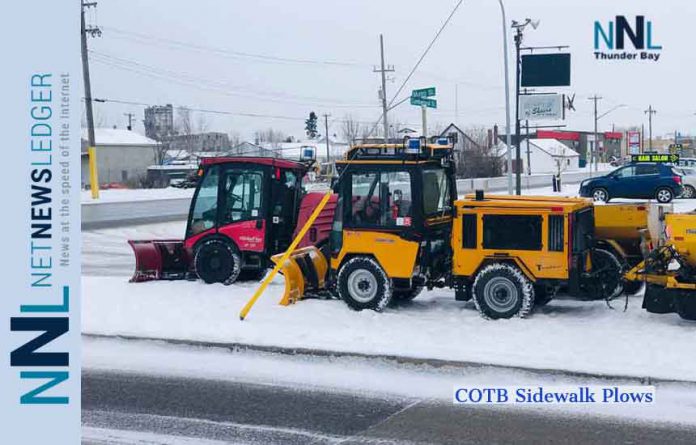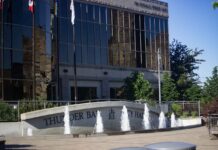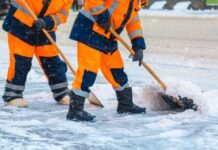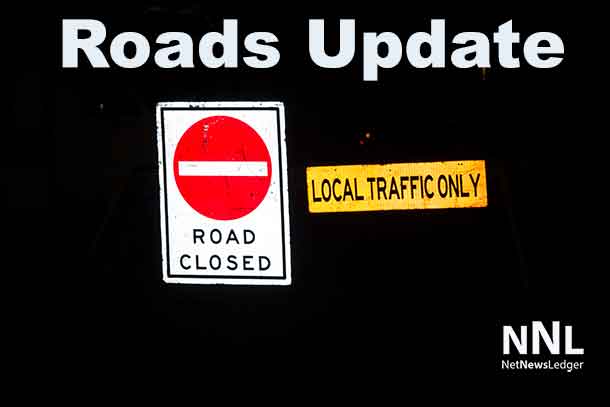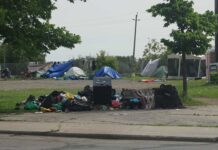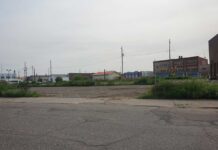THUNDER BAY – With the arrival of the first major snowfall this winter, snow clearing becomes a focus for both pedestrians and motorists.
Brad Adams, Thunder Bay’s Roads Manager has prepared this piece to share with you the commonly asked questions people in Thunder Bay have about roads, sidewalks and snow clearing.
Winter Maintenance Operations
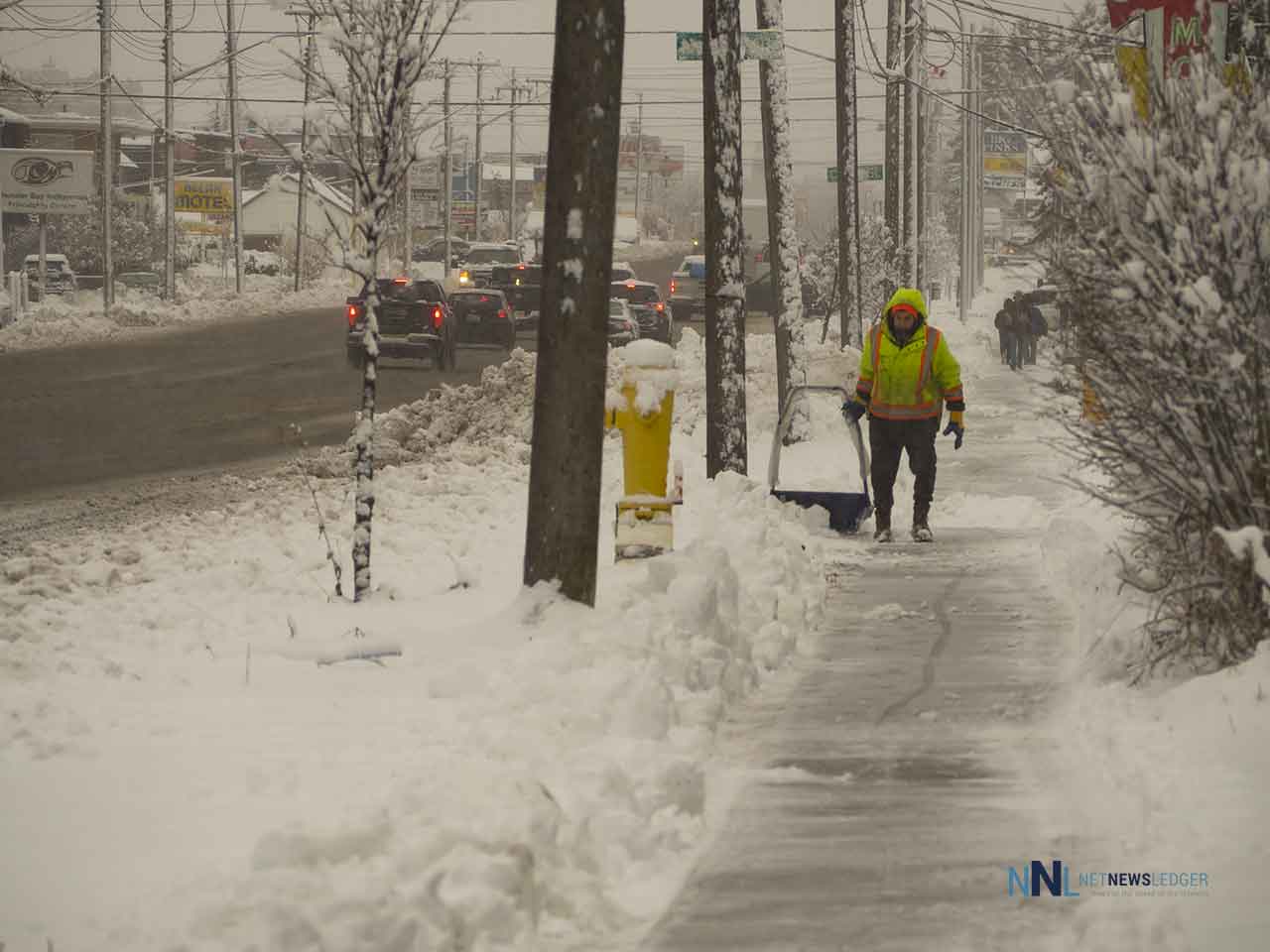
Frequently Asked Questions
1. Am I responsible for clearing the sidewalk adjacent to my property?
No, the City of Thunder Bay provides this service. All sidewalks in the city are cleared to a minimum snow pack condition after an accumulation of 5 cm or more of snow. Sidewalks are then sanded to provide friction for pedestrians.
2. The City plowed my local street, leaving a large windrow across my driveway. Will the City remove this snow?
No, windrows across driveways will not be cleared by City Crews. Residents are responsible for the maintenance associated with their driveway, including the portion that is on City property. It is that portion of the City property which has been designed to provide snow storage during the winter. The City does not give up the right to store snow in that area of the boulevard when it allows the residents’ driveway to encroach across City property. It is important to note City crews have the important task of plowing snow on all City streets as quickly as possible. Snow removal from driveways is not a program offered by the City.
3. Will the City remove high snowbanks near my driveway?
No, residents are responsible for maintaining and clearing their driveways and ensuring they can safely access and exit their driveway. It is recommended that when shoveling your driveway, pile snow on the side of the driveway away from the roadway and not to block your view of oncoming traffic. If traffic is passing your driveway westbound, pile your snow on the west side of your driveway so that when you look east you can see the oncoming traffic heading west.
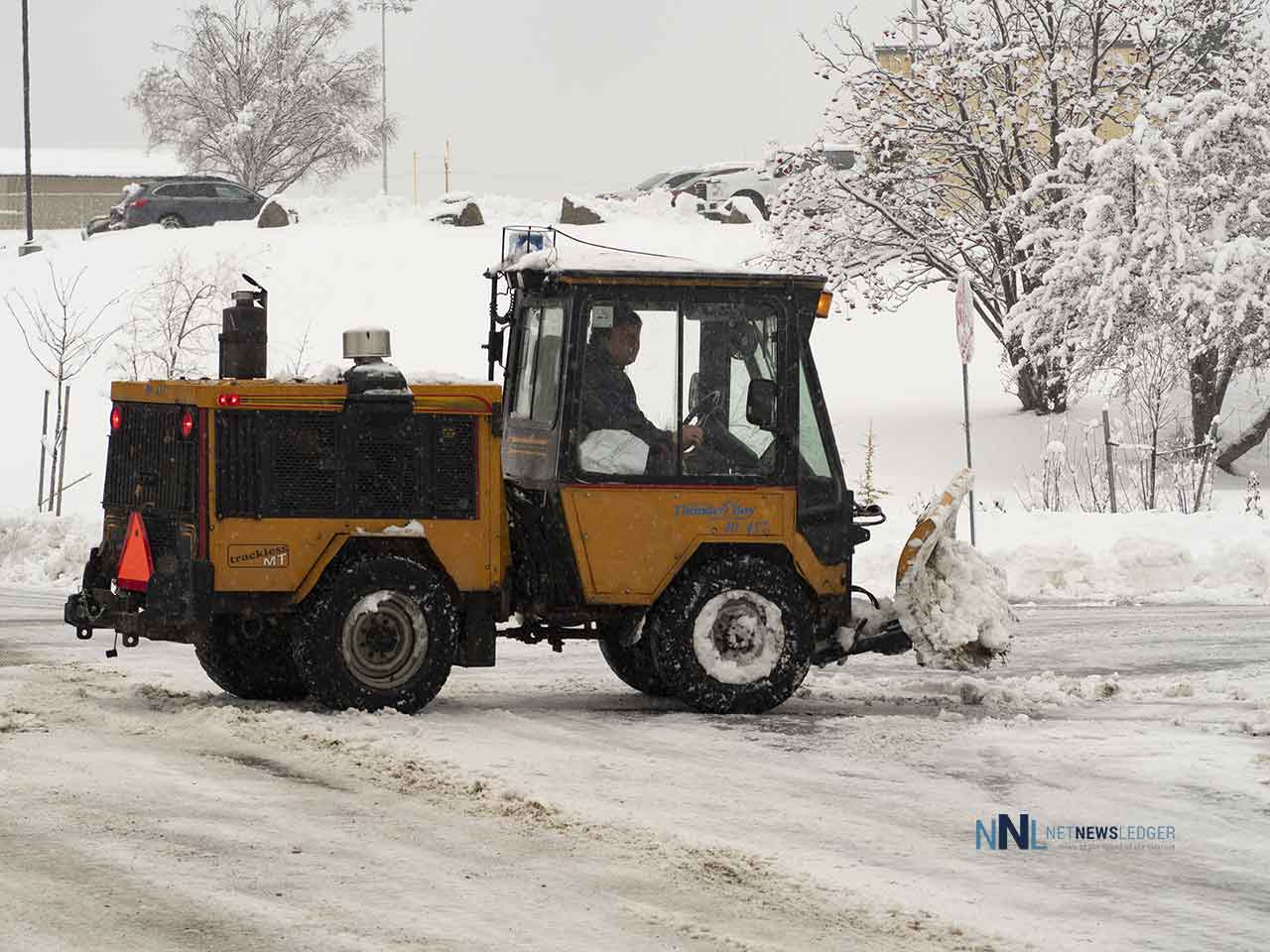
4. What roadways are plowed and sanded by the City?
When 5 cm or more of snowfall accumulates on the traveled portion of the road, the City begins to plow all major arterial roadways, collector streets, bus routes, and streets abutting schools, hospitals, homes for the aged, fire halls, ambulance stations, police stations and locations where conditions present safety concerns. Typically plowing operations commence at 2 am when the plows hit the roads and begin plowing priority routes which include arterial and collector roadways. Once these priority streets are completed, all local streets are plowed if more than 10 cm of snowfall accumulates.
5. Why does the City wait to plow their main roads between 2 am and 7 am?
The City of Thunder Bay does not allow parking on major arterial roadways, collector streets, bus routes, and streets abutting schools, hospitals, home’s for the aged, fire halls, ambulance stations, police stations and locations where conditions present safety concerns between 2 am – 7 am. This allows City plows to go out and clear all these areas in the most effective and efficient manner with no delays due to moving traffic, pedestrians, school children or parked cars blocking the plows. City crews can effectively clear all these streets within the prescribed hours (five hrs) even when accumulations reach 20 cm. This ensures that residents living on nearby local streets, which have not as yet been plowed can, make their way to the closest plowed road and continue their route. This also allows emergency vehicles to get very close to the area of an emergency call and provide aid even if the residential street is not as yet plowed.
6. What is Calendar Parking and why does the City plow many residential streets between 9 am and 5 pm?
The City of Thunder Bay instituted calendar parking during the winter months to allow plows to clear local streets more efficiently and effectively, unhampered by parked cars. Prior to initiating Calendar Parking plows would not be able to clear City streets because cars parked on both sides of the streets, blocking the path of the snow clearing equipment. Calendar Parking ensures that when the plow arrives, at least one side of the street is clear of parked cars and the plow can clear one side per day. This means that what used to take weeks to accomplish now can be done within three plowing days once the snow has stopped.
7. How does the Roads Section fight a winter storm?
Salting
The Roads Division relies on approximately 70 pieces of equipment which it either owns or contracts to fight a winter storm. When a winter storm hits Thunder Bay, our first line of defense is the sand/salt truck. If the temperature is above -14° Celsius, salt is placed on the road to prevent the snow and ice from bonding to the pavement. It is important to prevent the bonding of snow to pavement when ever possible so that the plows can be more effective clearing the snow off the pavement and achieving a bare pavement standard, as quickly as possible after the snow has stopped. The prevention of the bond is called the Brine Sandwich affect.
Sanding
If the temperature is much colder where salt cannot be used, then sand is applied to add friction to the surface of the road. While this is not as effective as salt, the sand provides some traction until the road can be cleared and bare pavement is restored. Because sand breaks down with traffic, during a prolonged cold snap it must be re-applied often, to ensure roads do not become icy and slippery.
Timing of Road Plowing
If the storm has arrived during the day, plows can only be used to remove some of the accumulation off roads and hills that have No Parking Restrictions, in place 24 hours per day. It is important to note that plowing at this time of the day is less effective since plows must contend with moving traffic and pedestrian traffic, which makes the plowing process slower and less effective. This type of plowing (when it can be used), allows people to travel safely home during a winter storm event. After plowing during the day, Crews will be sent home to rest so that they can return to plow at 2 am. At 2 am, the plows hit the roads and begin plowing priority routes which include arterial and collector roadways. At 3 am, sanders hit the road following the routes of the plows, sanding and salting the freshly plowed streets to prevent ice from forming behind the plows.
Sidewalk Plowing
At 3 am, the sidewalk plows are sent out to begin plowing the sidewalks along the freshly plowed streets. They do not go out at the same time as the road plows, so that sidewalk ends do not get plowed back in by the roads plows. The staggering of times works well, as long as there are no breakdowns with equipment.
8. When does the City plow major roads and when does the City plow local streets?
The Roads Maintenance Objectives require the City to plow major roads when 5 cm or more of snow accumulates on the traveled portion of the road, in one storm event. The Roads Maintenance Objective requires the City to plow local streets when 10 cm or more snow accumulates on the traveled portion of the road, in one storm event. Local streets are monitored and will be plowed once multiple smaller snow events have left actual accumulation on the roads of 10 cm or greater.
9. Why do the plows go out and plow streets or remove snow when it has not snowed?
During the winter, you may see a plow come down the street and push the snowbank which runs along the street further up onto the boulevard. This is called “Winging Bank” or “Benching”. It is done to widen streets which have narrowed, as a result of numerous winter storms in order to restore traffic capacity to the roadway and create more space for the next snowfall event. This allows vehicles room to park on the side of the road and allows emergency vehicles to navigate streets even when cars are parked on both sides of the road. This is especially important after 5 pm, where on-street parking is allowed. In some heritage areas of the city, older streets were built to narrower road standards than they are today. In these areas the roads narrow up quicker and may require actual snow removal operations to restore on street parking and to ensure emergency vehicles have access. The Roads Section will work with Police, Fire and EMS to identify these streets so they can be widened before they become too narrow.
10. How does the City of Thunder Bay Budget for Winter Maintenance Operations and are there minimum standards that they follow for winter maintenance?
Yes, the Roads Maintenance Objectives reflect the unique characteristics of the City of Thunder Bay and are designed to take advantage of the City’s Winter Parking Restrictions. The Winter Operations Objective is used to prepare the budget for winter operations each year. The budget is revised each year to reflect a “normal winter” based on a five year rolling average. The City does not budget for the worst case scenario. This would be too expensive and is not practical. The City does carry a Winter Contingency Reserve which is used to fund any over expenditure due to an abnormal winter season. The Winter Contingency Reserve is funded by any remaining surplus from the Winter Maintenance Budget when winters are less harsh and the budget is not entirely spent.
11. What resources and shifts are required to provide Winter Maintenance?
The City of Thunder Bay’s Roads Section operates year-round using one shift that runs 8 am to 4:30 pm, Monday to Friday. Staff is called in to fight the storm as required. In addition to the main shift the City also has a sanding/salting shift that consists of four sanders, which patrol the city Monday to Friday, between 12 midnight and 8 am. These operators and trucks deal with any icy conditions which occur during those hours and alert their supervisors when the weather requires more resources to be deployed. On weekends, staff is called in as needed to respond to any winter conditions that may arise. In addition to these two shifts and when required, the Roads Section will create two snow removal crews which remove snow from the business areas and high traffic areas between the hours of 11 pm and 7 am, operating between Sunday and Friday. It is important to note that these crews must be made up of the same staff that plows the streets. Therefore, snow removal can only take place during periods when the crews are not plowing streets due to a winter storm event. The City places plowing roads and sidewalks as the number one priority. If it snows, the snow removal crews return to their plowing duties. Where and when possible, snow removal crews will operate during the day to remove snow to widen roads and streets, and deal with line of sight issues at intersections.
12. How often does the City sand/salt roadways?
This depends on weather conditions and safety concerns that arise from the formation of black ice and frost on city roads. During a storm, major roads are sanded/salted to create the brine sandwich affect and prevent the bond of snow and ice on the pavement. Local streets are generally sanded/salted at curves and at intersections, to prevent icing in those critical areas. At all other location, only sand is applied. All sand/salt trucks are equipped with infrared thermometers which the operators use to measure the temperature of the road surface. It is the road surface temperature they use to determine if sand or salt is required, not the air temperature. This ensures that material is only being used when the road temperature is below freezing and will allow ice to form, or will cause ice to form from falling snow or rain.
13. How often does the City remove snow?
Snow removal is only performed to restore traffic capacity to roadways and to reduce line of sight obstructions at intersections based on the priorities identified in the Roads Maintenance Objectives. Snow removal is only performed after significant accumulation when snow storage within the road right of way is exceeded and is an impact on traffic capacity to the roadway. There are some winters when snow removal is not required. The priorities in the Roads Maintenance Objective identifies that snow removal will occur in the core areas first, followed by major arterial roadways and bus routes.
14. Who is responsible for cleaning bus stops?
The Transit Division hires a contractor each year to clear bus stops. The frequency of clearing is dependent on the number of storm events each year.
15. The access to the crosswalk is blocked by a snow bank. Will the City be back to open that up?
Yes, sometimes when the road plow breaks down, the sidewalk plow gets ahead of it. The road plow will continue plowing once repaired, but it unfortunately fills in the freshly plowed crosswalk. In this situation it has been determined not to delay the sidewalk plows because their beat may cross over into other road plow beats which are operating on schedule. It is important to clear as many sidewalks as possible and once this is done, the sidewalk plow will return to the plugged crosswalks and open them up.
16. What criteria does the City use to classify roads on a priority scale?
The priority is based on traffic volume, traffic speed, steepness of road grade, structures, susceptibility to icing, proximity to critical services and uses the Parking Restriction Hours to plow streets in the most effective and efficient manner.

